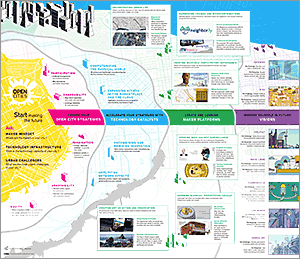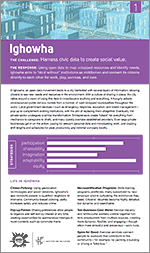Open Cities Map + Toolkit

Open Cities: How the maker mindset & technology
are reinventing urban life
Cities have always been the place where our imaginations, hopes and dreams live ... they are the nexus where people, ideas, and possibilities come together to create the future.
Over the next decades our cities will unlock as-yet-unimagined possibilities of urban life. They will draw in nearly a billion new urban dwellers and spur the largest and fastest reinvention of our built environment in human history.  In the process, they will capture the creativity and inventiveness of a new breed of citizens—the makers— opening up participation, resources, imagination, spaces, and economic opportunity. These makers, in turn, will quite literally fabricate a new kind of city: the open city.
In the process, they will capture the creativity and inventiveness of a new breed of citizens—the makers— opening up participation, resources, imagination, spaces, and economic opportunity. These makers, in turn, will quite literally fabricate a new kind of city: the open city.
Start Making the Future
The Open Cities map is a tool to help you cultivate a maker mindset as you participate in the reinvention of the city as an open city. Use it to anticipate future challenges, leverage technology catalysts, zoom in on zones of innovation, and make your city—or any city—a better place for everyone to work, play, and make the future.
This map walks you through the open city, starting with STRATEGIES, followed by TECHNOLOGY CATALYSTS, then MAKER PLATFORMS, and finally immersing you in VISIONS OF THE FUTURE. Get started by asking the following questions:
- Where is the maker movement in your city?
- How does it reflect your unique culture?
- What is the technology capacity of your city, and is it sufficient to seize future opportunities?
- What are the most urgent challenges your city faces that this convergence of makers and technology can address?
Seven Visions of Open Cities
 This card set expands on the seven visions of open cities cited in the map and explores how different strategies of openness can be applied to discrete urban challenges. Leveraged in combination, the strategies can generate new innovations and offer tools to remake your own city.
This card set expands on the seven visions of open cities cited in the map and explores how different strategies of openness can be applied to discrete urban challenges. Leveraged in combination, the strategies can generate new innovations and offer tools to remake your own city.
Each vision card contains 1) a summary of the challenge and response, 2) a brief description of the city and how it came to be, and 3) a series of on-the-ground snapshots of different government and commercial services available to residents of the city.
The front of each card contains a graph that visually depicts how aggressively the city is implementing each of the strategies. Use them to think through how the strategies shape the life in each city and cross-reference them to get a bigger picture view of the range of possibility.
The back of each card lists tensions—unanticipated consequences or unresolved issues resulting from each cities implementation of its strategies. Additionally, two signals (real world examples that point to the future depicted in that vision) are shown that can help you understand how this future is playing out today.
Publication Date
- Public Release: Fall 2015
- Member-only Release: Fall 2014
To learn more ...
- Learn about becoming a Future 50 Partner
- Contact Sean Ness | 650-233-9517 | sness@iftf.org




